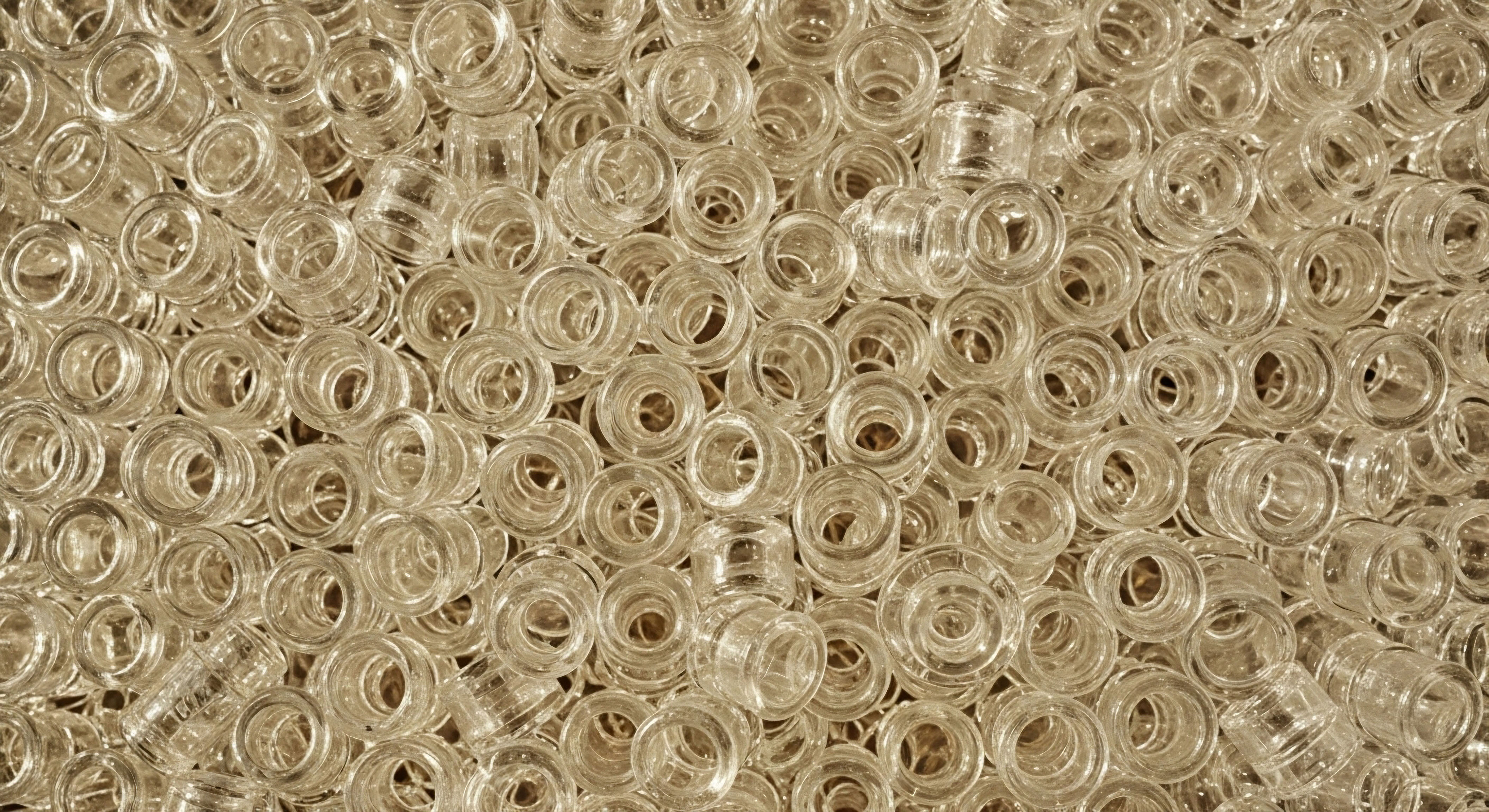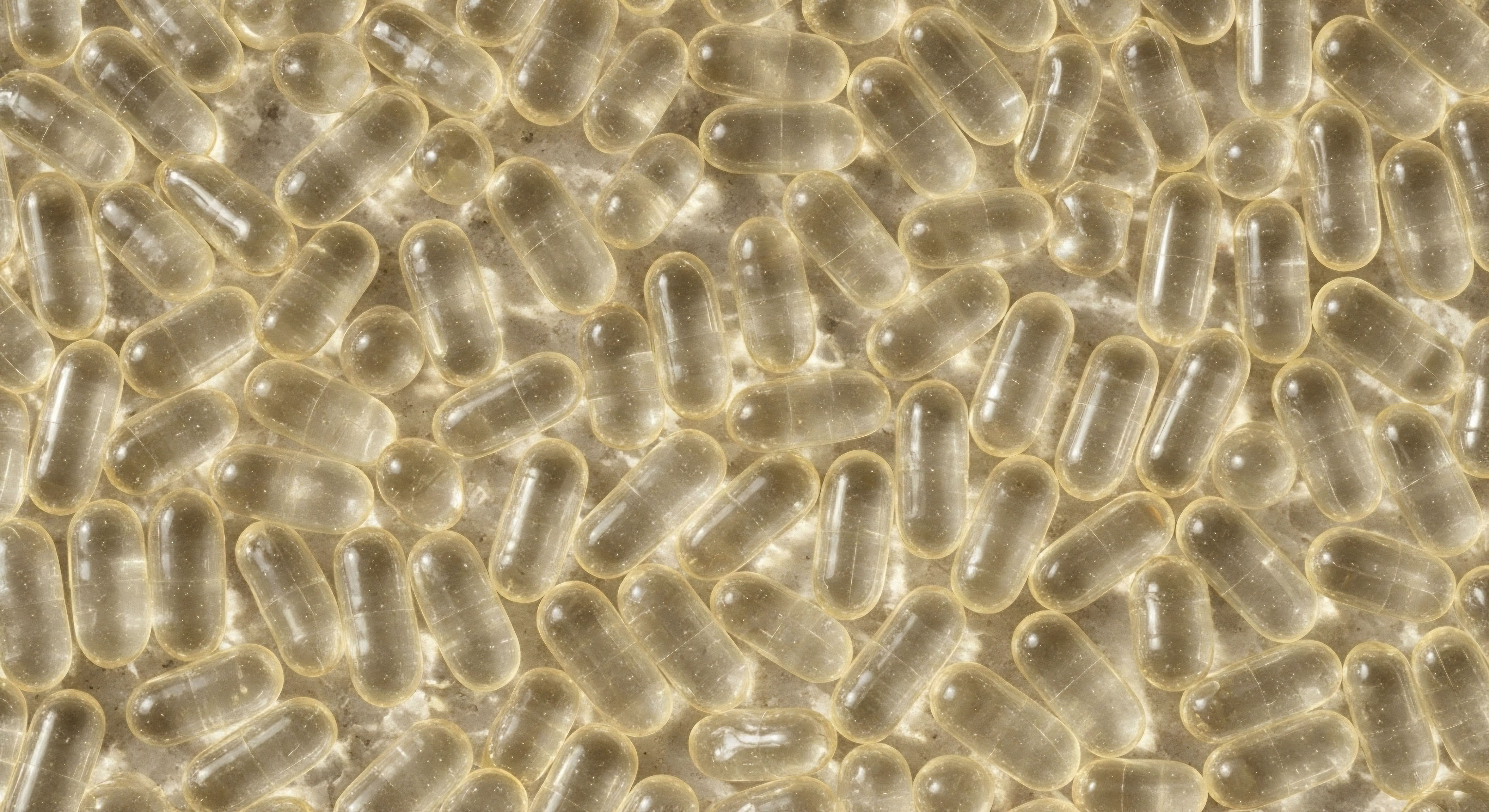

Fundamentals
You may feel it as a persistent, low-grade fatigue that sleep does not resolve. It could manifest as a subtle shift in your moods, an unwelcome change in body composition, or a general sense of being unwell that you cannot quite name. These experiences are valid.
They are data points, your body’s method of communicating a change in its internal environment. Often, the conversation your body is trying to have concerns its ability to manage its hormonal messengers, particularly estrogen. Understanding how your body processes and eliminates estrogen is a foundational step in reclaiming your vitality.
The body’s primary site for this sophisticated process is the liver, which functions as a brilliant and tireless biochemical processing plant. Every hormone, nutrient, and compound that enters your bloodstream eventually passes through the liver for assessment. Here, the liver performs what is broadly known as detoxification.
This term refers to a natural, biological function of transformation. The liver takes compounds that are no longer needed, such as used estrogen, and converts them into forms that can be safely excreted from the body.

The Two-Phase System of Hormonal Clearance
The liver’s process for handling estrogen is an elegant, two-stage system. Each stage depends on the other for the entire operation to succeed. A disruption in either phase can lead to an accumulation of hormonal intermediates, which can contribute to the symptoms you may be experiencing.

Phase I the Activation Step
The first step is known as Phase I Hydroxylation. During this phase, a family of enzymes called Cytochrome P450 (CYP) modifies the estrogen molecule. This chemical alteration makes the estrogen molecule more water-soluble and prepares it for the next stage. Think of this as the initial sorting and preparation of materials in a recycling facility. The goal is to change the structure of the estrogen to ready it for final packaging and removal.

Phase II the Packaging Step
Following activation, the modified estrogen molecule enters Phase II Conjugation. In this stage, the liver attaches another molecule to the estrogen, effectively “packaging” it for disposal. This process neutralizes the activated estrogen and makes it ready for elimination through urine or bile. This is the final, critical step that ensures used hormones leave the body efficiently. Specific nutrients from our diet provide the raw materials for this packaging process, making dietary choices a direct modulator of hormonal balance.
Your daily food choices directly supply the essential building blocks your liver requires to effectively process and eliminate estrogen.

How Do Dietary Choices Support This System?
Your diet provides the essential tools your liver needs to perform both phases of estrogen clearance. Certain foods contain compounds that can support, or in some cases hinder, these detoxification pathways. For instance, the family of cruciferous vegetables, which includes broccoli, cauliflower, and kale, is a powerful ally in this process. These vegetables contain specific phytonutrients that directly support the enzymes involved in Phase I and Phase II.
Conversely, a diet high in processed foods and low in nutrient density can place a significant burden on the liver. When the liver is occupied with processing a high volume of inflammatory compounds or synthetic chemicals, its capacity to manage hormonal clearance can be diminished.
This can lead to a bottleneck in the system, where estrogen and its byproducts are not efficiently removed. Recognizing this connection between what you eat and how you feel is the first principle of reclaiming your biological function.


Intermediate
A deeper examination of estrogen metabolism reveals a complex and finely tuned biological process. The body does not just eliminate a single entity called “estrogen.” Instead, it metabolizes different forms, primarily estradiol (E2) and estrone (E1), into various downstream metabolites. The balance of these metabolites is a critical factor in overall health. Your dietary habits have a direct and measurable impact on which metabolic pathways are favored, thereby influencing this delicate balance.

Phase I Metabolites a Tale of Three Pathways
During Phase I hydroxylation, your liver directs estrogen down one of three main pathways, each producing a different type of metabolite. The pathway chosen is determined by the activity of specific Cytochrome P450 enzymes. Your genetics and lifestyle, particularly your diet, influence the efficiency of these enzymes.
- The 2-Hydroxy Pathway (2-OHE1) This is generally considered the most protective pathway. The resulting 2-hydroxyestrone metabolite is a weak estrogen that does not exert strong effects on tissues. It is also easily conjugated in Phase II for elimination. Certain foods can encourage this pathway.
- The 16-Hydroxy Pathway (16α-OHE1) This pathway produces a much more potent estrogenic metabolite. High levels of 16α-hydroxyestrone are associated with increased estrogenic activity in the body, which can contribute to symptoms of hormonal imbalance.
- The 4-Hydroxy Pathway (4-OHE1) This pathway produces a metabolite that can generate reactive oxygen species (ROS), or free radicals. These molecules can cause oxidative stress and damage to cellular structures if not properly neutralized and eliminated through Phase II detoxification.
The goal of a supportive dietary strategy is to promote the 2-hydroxy pathway while ensuring the efficient Phase II clearance of all metabolites, especially the 4-OHE1 metabolite. An imbalance, often measured by the 2/16 ratio, can be a key indicator of how well your body is managing its estrogen load.
The balance between different estrogen metabolites, which is directly influenced by nutrition, is a key determinant of hormonal health.

Nutritional Modulation of Detoxification Pathways
Specific nutrients and phytonutrients act as signals that can upregulate or downregulate the enzymatic activity in both Phase I and Phase II. This provides a powerful means of guiding estrogen metabolism toward a more favorable profile.

Supporting Phase I Balance
The compounds found in cruciferous vegetables are particularly noteworthy for their role in Phase I. Indole-3-carbinol (I3C), and its digestive product 3,3′-diindolylmethane (DIM), have been shown to promote the activity of the enzymes that favor the 2-hydroxy pathway. This effectively shifts estrogen metabolism away from the more problematic 16-hydroxy and 4-hydroxy pathways.
Foods rich in I3C include broccoli, Brussels sprouts, cabbage, and cauliflower. Additionally, compounds in berries and celery may help temper the activity of enzymes that produce less desirable metabolites.

Enhancing Phase II Conjugation
An efficient Phase II is essential to neutralize and excrete the metabolites created in Phase I. Several distinct conjugation pathways exist, and each relies on specific nutrient cofactors.
- Methylation This pathway, which uses the COMT (Catechol-O-methyltransferase) enzyme, is particularly important for neutralizing the 4-OHE1 metabolite. It requires a steady supply of B vitamins (especially B6, B12, and folate) and magnesium as cofactors. Leafy green vegetables, legumes, and nuts are excellent sources of these nutrients.
- Sulfation This pathway uses sulfur-containing compounds to package estrogen metabolites. Foods rich in sulfur, such as garlic, onions, and eggs, provide the necessary substrates.
- Glucuronidation This is a primary pathway for clearing many estrogen metabolites. It can be supported by compounds like calcium D-glucarate, found in apples, oranges, and cruciferous vegetables. This process helps bind the estrogen in the gut to prevent its reabsorption.

The Critical Role of the Estrobolome
The journey of estrogen elimination does not end in the liver. Packaged estrogens are sent to the gut for excretion via bile. Here, the health of your gut microbiome, often called the estrobolome, becomes a central factor. The estrobolome is the collection of gut bacteria capable of metabolizing estrogens.
Certain unhealthy gut bacteria produce an enzyme called beta-glucuronidase. This enzyme can “unpackage” the estrogens that the liver has prepared for excretion. This process allows the estrogens to be reabsorbed back into circulation, increasing the body’s total estrogen load and undermining the liver’s hard work. A diet high in fiber from diverse plant sources is fundamental to maintaining a healthy gut microbiome. Fiber feeds beneficial bacteria and helps bind the excreted estrogens, ensuring their final removal from the body.
| Detoxification Phase | Key Biological Process | Supportive Dietary Components | Primary Food Sources |
|---|---|---|---|
| Phase I Hydroxylation | Activation of estrogen and directing it down specific metabolic pathways (2-OH, 4-OH, 16-OH). | Indole-3-Carbinol (I3C), Diindolylmethane (DIM), Resveratrol, Ellagic Acid. | Broccoli, Cauliflower, Cabbage, Berries, Grapes, Celery. |
| Phase II Conjugation | Neutralization and packaging of activated estrogen metabolites for excretion. | B Vitamins (Folate, B6, B12), Magnesium, Sulfur Compounds, Calcium D-Glucarate. | Leafy Greens, Legumes, Nuts, Garlic, Onions, Apples. |
| Gut Elimination | Binding and final excretion of packaged estrogens, preventing reabsorption. | Dietary Fiber, Probiotic and Prebiotic Foods. | Whole Grains, Legumes, Vegetables, Fermented Foods. |


Academic
A sophisticated understanding of hormonal health requires moving from general dietary recommendations to a more precise, molecular framework. The field of nutrigenomics provides this lens, examining the intricate interactions between dietary compounds and an individual’s genetic expression. When applied to estrogen detoxification, this discipline reveals how specific phytonutrients can modulate enzymatic activity at the genetic level, offering a targeted strategy to support individuals with inherent predispositions to hormonal imbalance.

Genetic Polymorphisms and Estrogen Metabolism
The enzymes that govern estrogen detoxification, such as the Cytochrome P450 family and COMT, are encoded by genes. Minor variations in these genes, known as Single Nucleotide Polymorphisms (SNPs), are common in the population. While not diseases themselves, these SNPs can result in enzymes that are faster or slower than average. Such variations can profoundly impact an individual’s ability to safely metabolize estrogen.
- CYP1B1 Polymorphisms The CYP1B1 enzyme is primarily responsible for the 4-hydroxy pathway. Certain SNPs in the CYP1B1 gene can lead to an overactive enzyme, resulting in a higher production of the potentially genotoxic 4-OHE1 metabolite. Individuals with this genetic profile may have a greater need for dietary compounds that can both temper CYP1B1 activity and robustly support Phase II clearance.
- COMT Polymorphisms The COMT enzyme is critical for methylating and neutralizing the 4-OHE1 metabolite. A common SNP results in a COMT enzyme that is three to four times slower than the standard version. An individual with this “slow COMT” variation may have a reduced capacity to clear 4-OHE1, leading to its accumulation. This creates a clinical imperative to ensure an abundant supply of methylation cofactors, such as magnesium and specific B vitamins, through diet and supplementation.
This genetic individuality explains why two people can follow a similar diet yet experience different hormonal outcomes. It underscores the need for personalized protocols that account for an individual’s unique biochemical landscape.

Molecular Mechanisms of Key Phytonutrients
Certain dietary compounds do not just provide raw materials; they act as potent signaling molecules that influence gene expression related to detoxification.

Sulforaphane and Nrf2 Activation
Cruciferous vegetables contain glucosinolates, which are converted to bioactive compounds like sulforaphane. Sulforaphane is a powerful activator of the Nuclear factor erythroid 2-related factor 2 (Nrf2) pathway. Nrf2 is a transcription factor that acts as the master regulator of the body’s antioxidant response.
When activated by sulforaphane, Nrf2 binds to the Antioxidant Response Element (ARE) in the DNA of liver cells. This binding switches on the genes that produce a suite of protective Phase II enzymes, including Glutathione S-transferases (GSTs) and Quinone Reductase (NQO1). These enzymes are particularly effective at neutralizing the reactive 4-OHE1 metabolite, providing a direct molecular link between eating broccoli sprouts and enhancing the clearance of potentially harmful estrogen byproducts.
Phytonutrients like sulforaphane function as epigenetic modulators, directly influencing the genetic machinery responsible for safe hormonal clearance.

Resveratrol and Curcumin as Enzyme Modulators
Other phytonutrients exhibit selective modulating effects on Phase I enzymes. Resveratrol, found in grapes and berries, has been shown to enhance the activity of CYP1A1, which contributes to the favorable 2-hydroxy pathway. Conversely, compounds like chrysoeriol in celery can selectively inhibit the overactivity of CYP1B1. Curcumin, the active compound in turmeric, demonstrates a dual action. It supports Phase II enzymes while also possessing potent anti-inflammatory properties that reduce the systemic inflammation that can burden the liver’s detoxification capacity.

What Is the Clinical Application of This Knowledge?
This detailed molecular understanding allows for the creation of highly targeted dietary protocols. For a woman on testosterone therapy who also needs to manage her estrogen levels, a diet rich in cruciferous vegetables is not just a healthy choice; it is a clinical tool to promote the 2-hydroxy pathway and reduce the estrogenic load that might otherwise require higher doses of an aromatase inhibitor like Anastrozole.
For an individual with a slow COMT SNP, a diet emphasizing leafy greens, beets, and other methyl donor sources becomes a non-negotiable part of their wellness protocol. This personalized approach, grounded in biochemistry and genetics, moves dietary advice from the realm of general guidance to that of precise, therapeutic intervention.
| Phytonutrient | Primary Source | Molecular Mechanism of Action | Clinical Relevance |
|---|---|---|---|
| Sulforaphane | Broccoli Sprouts, Cruciferous Vegetables | Activates the Nrf2 transcription factor, leading to increased expression of Phase II enzymes like GST and NQO1. | Enhances the neutralization and clearance of the 4-OHE1 metabolite, reducing oxidative stress. |
| Indole-3-Carbinol / DIM | Cabbage, Brussels Sprouts, Broccoli | Promotes the expression and activity of CYP1A-family enzymes over others, shifting metabolism toward the 2-OHE1 pathway. | Improves the ratio of 2-OHE1 to 16α-OHE1, lowering the overall estrogenic burden on tissues. |
| Resveratrol | Grapes, Berries, Peanuts | Enhances CYP1A1 activity, which contributes to the formation of the protective 2-OHE1 metabolite. | Supports the preferential production of less potent estrogen metabolites. |
| Curcumin | Turmeric | Induces Phase II enzymes (like GST) and has broad anti-inflammatory effects, reducing the liver’s overall toxic load. | Supports clearance pathways while mitigating systemic inflammation that can impair liver function. |
| Ellagic Acid | Berries, Pomegranates, Walnuts | May reduce the overactivity of CYP1A1, helping to balance Phase I metabolism. | Helps modulate and balance the initial phase of estrogen processing. |

References
- Hodges, Romilly E. and Deanna M. Minich. “Modulation of Metabolic Detoxification Pathways Using Foods and Food-Derived Components ∞ A Scientific Review with Clinical Application.” Journal of Nutrition and Metabolism, vol. 2015, 2015, pp. 1-23.
- Smith-Warner, Stephanie A. et al. “Intake of Fruits and Vegetables and Risk of Breast Cancer ∞ A Pooled Analysis of Cohort Studies.” JAMA, vol. 285, no. 6, 2001, pp. 769-776.
- Baker, J. M. Al-Nakkash, L. & Herbst-Kralovetz, M. M. “Estrogen-gut microbiome axis ∞ Physiological and clinical implications.” Maturitas, vol. 103, 2017, pp. 45-53.
- Bradlow, H. L. et al. “2-hydroxyestrone ∞ the ‘good’ estrogen.” Journal of Endocrinology, vol. 150, Suppl, 1996, pp. S259-S265.
- Minich, Deanna M. and Benjamin I. Brown. “A Review of Dietary (Phyto)Nutrients for Glutathione Support.” Nutrients, vol. 11, no. 9, 2019, p. 2073.
- Lord, Richard S. and J. Alexander Bralley. Laboratory Evaluations for Integrative and Functional Medicine. Metametrix Institute, 2012.
- Hyman, Mark. Food ∞ What the Heck Should I Eat?. Little, Brown and Company, 2018.
- The Endocrine Society. “Hormones and Health.” Endocrine.org, 2022.
- Tsuchiya, Y. Nakajima, M. & Yokoi, T. “Cytochrome P450-mediated metabolism of estrogens and its regulation in human.” Cancer Letters, vol. 227, no. 2, 2005, pp. 115-124.
- Fowke, J. H. et al. “Urinary estrogen metabolites and breast cancer risk ∞ a case-control study.” Cancer Epidemiology, Biomarkers & Prevention, vol. 9, no. 4, 2000, pp. 337-342.

Reflection
The information presented here offers a map of your internal biological terrain. It details the pathways, the processes, and the molecular signals that govern your hormonal health. This knowledge is a powerful tool, shifting the perspective from one of passive experience to one of active participation. You now have a deeper appreciation for the conversation occurring within your cells after every meal.
Consider your own lived experience and the symptoms you have felt. How might they align with the biological systems described? This is not a call for self-diagnosis, but an invitation to introspection. Understanding the ‘why’ behind your body’s signals is the first step. The next is to determine your unique needs.
This map can show you the roads, but the specific path you take is yours to chart, ideally with the guidance of a professional who can help you interpret your body’s specific data and co-create a personalized strategy for lasting vitality.



